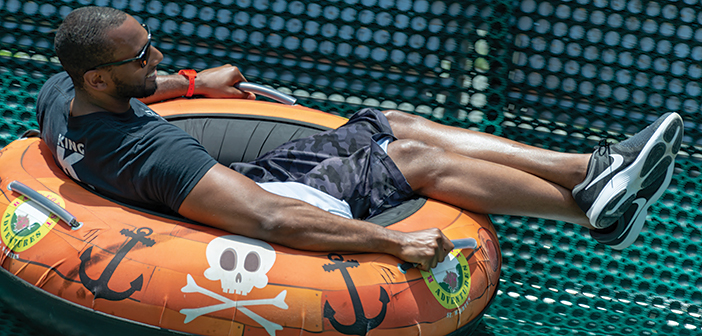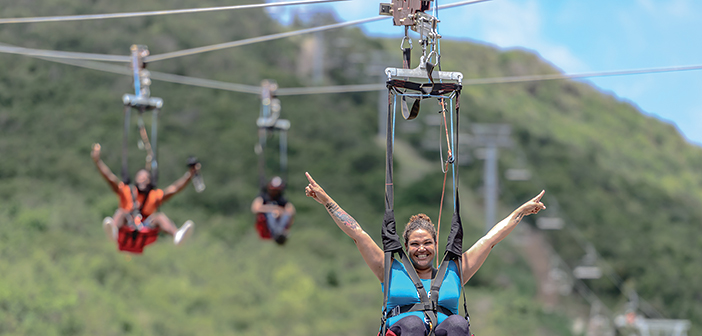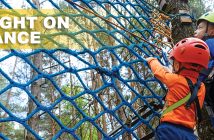Hurricanes have made themselves felt across much of the Gulf Coast, Southeastern U.S. and the Caribbean in recent years, with Hurricane Florence being the most recent (at press time, anyway). Among the others was Hurricane Irma, which wreaked havoc from late August to mid-September of 2017. It was the most intense hurricane to strike the continental U.S. since hurricane Katrina in 2005, and the strongest Atlantic-based hurricane ever recorded, outside the Gulf of Mexico and the Caribbean Sea.
The hurricane’s arrival in the Caribbean was especially violent, and coincided with the planned opening of Rockland Estate, St. Maarten, a resort and adventure park operated by Rainforest Adventures. The Estate includes four main attractions, including the Flying Dutchman zip line—four parallel racing zip lines that are the steepest in the world, at 42 degrees. Built by Terra Nova, this ZipRider installation is 2,538 feet long, with more than a thousand feet of vertical drop.
The hurricane, whose winds reached a sustained 185 mph on St. Maarten, tested the mettle of the design of the attractions and of the resort’s staff. The scheduled opening date for the park was Sept. 10—four days after Irma roared through on Sept. 6.
Despite the severity of the hurricane, the park itself endured mostly minor damage, and the new resort and adventure park opened less than three months after the intended opening date. The lack of major damage stemmed, in part, from design that took hurricane-force winds into account, and preparedness steps that further protected structures and equipment from damage. In all, this was a case study in how to design for and deal with extreme weather events.
Battening Down
“Our employees and contractors showed up in force and worked very hard to protect all they had built. They deserve tremendous credit for being St. Maarten Strong. Irma showed what an awesome team we have at Rockland Estate,” Rainforest Adventures chief engineer John Dalton posted on stmaarten-info.com, after the storm had passed.

As part of the preparations, the zip cables were wrapped around secure posts at the top and bottom stations.
The park has a staff of around 80, and with 98 percent of them locals to the island, virtually all of them stayed. As the hurricane bore down on St. Maarten, it took two days of preparations to batten down the hatches, which took a variety of forms, before staff left the site for the relative safety of their residences, according to Julie Zambrini, director of sales and marketing for Rainforest Adventures, St. Maarten. Zambrini was one of those who remained on the island during Irma. “We were as prepared as we could have been,” she adds.
A main decision for the park operators focused on whether or not to take down the four cables of the Flying Dutchman, which were already in place as the hurricane approached. Initially, experts believed the cables could stay up and withstand the winds. But with the potential for damage to the cables from flying debris, park operators reconsidered. They decided to de-tension the cables and lower them into the forest, where they were secured. >>
“Even if the cables can withstand 250 mph winds, the stuff flying around can do damage,” says Eric Cylvick, CEO and founder of Terra Nova, which designed and built the Flying Dutchman. As it turned out, the sustained 185 mph winds on St. Maarten were accompanied by gusts up to 225 mph.
To de-tension and lower the cables, Terra Nova’s crews utilized an electric HIT-TRAC device designed for high-tension cable pulling. This was the first time Terra Nova had used an electric tensioning system for a zip line rather than a gas-powered system. It chose the electric version because it can both de-tension and tension cables, where a gas-powered system can only tighten them.
“The storm was definitely exciting and a little scary,” says Cylvick, “but we had the design for this technology six years before we built it, and we were prepared.”

SkyTrac knew the chairlift would require special precautions and design. Photo: Richard Hazel.
As part of the preparations, the cables were wrapped around secure posts, located at the top and bottom stations. They were also secured at multiple points on the ground and in the forest canopy. They endured wind, rain, flying debris, and more during the storm. Once the cables were raised and re-tensioned, the park owners used a magnetic rope test (MRT) scanning device, pulled up and down the length of the cables, and determined that all four remained fit for use.
“The cable took a beating, but we were lucky, in that we didn’t have to swap it out after the storm,” says Cylvick.
Additionally, the top tower of the Flying Dutchman was struck by lightning multiple times, and needed repairs. A fiberglass-insulated antenna mast at the top station that was destroyed by flying debris, and some of the wood decking at the top and bottom stations had to be repaired. But Cylvick says the structures held up “extremely well.”
The location of the park was selected for its stunning scenery, but that exposed site also came with logistical challenges. That applied to the park’s scenic chairlift, another of the resort’s four attractions, not just the zip lines.
Dalton, along with the engineering team from lift supplier SkyTrac, had chosen to locate the lift’s upper terminus at the highest point on the Dutch side of the island. That affords the best views, of course, but Dalton also knew this would require special precautions and design to withstand the potential wind and rain a hurricane can bring. The precautions included a preparedness plan in case things got crazy, which they did.

The worst damage was to the tube ride, which had to be redesigned and reinstalled.
In a blog post written for skytraclifts.com well before Irma hit, Dalton had described the philosophy behind the design and construction of the lift, and how the resort would prepare for the impact of a major hurricane. “If there is a big hurricane, the sheave trains [the sets of rollers on the towers that support the haul rope]could get bent a little bit, which is repairable. We can drop all the chairs [remove them from the cable before the storm hits]and leave the cable on [the towers]…. In the worst case, there will probably still be one cable left on the tower, reducing the stress a little, and hopefully not get any towers bending. We have short stubby little towers anchored into the rocks. With all that we’ve put into consideration, that top terminal is going to stay put.”
As the hurricane closed in, park crews strapped down the chairs, shut down all electrical power, and locked up everything that could become airborne in the park’s buildings, which were fortified with reinforced hurricane shutters. >>
The chairlift, like the zip lines, came through the storm with minimal damage. The worst damage was to the tube ride, which had to be redesigned and reinstalled. But even with all that, less than three months later, the park was ready for the resort’s opening.
A Success Story
The repairs did not happen overnight, of course. It was about a week after the storm had passed before the first staff members returned to the resort and began making repairs, Zambrini says. She credits the team for its detailed attention to safety and their swiftness in preparing for the storm, as well as for getting the park back to working order afterward.
With all features up and running quickly, the personnel involved in planning, design, and hurricane preparations were more than pleased with the coordination, organization, and effectiveness of their plans. The Dutchman and other attractions were ready and waiting to open on Nov. 24, as part of the official opening of Rockland Estate, after a two-and-a-half month delay.

The staff were able to get the park ready for the resort’s grand opening Nov. 24, a mere two and a half months after the storm. Photo: Richard Hazel.
It’s not often that a new park experiences a worst-case scenario before it even opens, but proper planning helped Rockland Estate survive the test nonetheless. Cylvick, who toured the site this past June, was impressed with the resilience of the structures, and the team’s ability to open when they did.
“I simply don’t think it could have gone any better,” he says.






